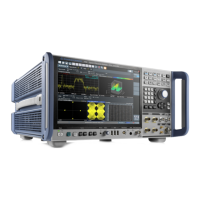Common Measurement Settings
R&S
®
FSW
410User Manual 1173.9411.02 ─ 43
f
IF
: Intermediate frequency (variable; defined internally depending on RBW and span)
Thus, depending on the required frequency band, the appropriate order of harmonic
must be selected. For commonly required frequency ranges, predefined bands with the
appropriate harmonic order setting are provided. By default, the lowest harmonic order
is selected that allows conversion of input signals in the whole band.
For the band "USER", the order of harmonic is defined by the user. The order of har-
monic can be between 2 and 128, the lowest usable frequency being 16.88 GHz.
The frequency ranges for pre-defined bands are described in Table 14-6.
Changes to the band and mixer settings are maintained even after using the [PRESET]
function. A "Preset band" function allows you to restore the original band settings.
Extending predefined ranges
In some cases, the harmonics defined for a specific band allow for an even larger fre-
quency range than the band requires. By default, the pre-defined range is used. How-
ever, you can take advantage of the extended frequency range by overriding the
defined start and stop frequencies by the maximum possible values ("RF Overrange"
option).
Additional ranges
If due to the LO frequency the conversion of the input signal is not possible using one
harmonic, the band must be split. An adjacent, partially overlapping frequency range
can be defined using different harmonics. In this case, the sweep begins using the har-
monic defined for the first range, and at a specified frequency in the overlapping range
("handover frequency"), switches to the harmonic for the second range.
Which harmonics are supported depends on the mixer type.
Two-port and Three-port Mixers
External mixers are connected to the R&S FSW at the LO OUT/IF IN and IF IN con-
nectors.
When using three-port mixers, the LO signal output from the R&S FSW and the IF
input from the mixer are transmitted on separate connectors, whereas for two-port mix-
ers, both signals are exchanged via the same connector (LO OUT/IF IN). Because of
the diplexer contained in the R&S FSW, the IF signal can be tapped from the line which
is used to feed the LO signal to the mixer.
For measurements with a bandwidth larger than 2 GHz and an external mixer, only 3-
port mixers are supported.
For more information see "External Mixers and Large Bandwidth Extension Options"
on page 413.
Data Input and Output

